 Wang Chunchen at CAFA Art Museum © Wang Chunchen Courtesy CAFA Art Museum
Wang Chunchen at CAFA Art Museum © Wang Chunchen Courtesy CAFA Art Museum
Wang Chunchen at CAFA Art Museum © Wang Chunchen Courtesy CAFA Art Museum
On Feb 22, 2013, China has announced the appointment of Wang Chunchen as the curator of Chinese Pavilion in the 55th Venice Biennale, which will open from June 1 throughl Nov 24, 2013. Wang Chunchen, associate professor of the Academic Department of CAFA Art Museum, chooses “Transfiguration” for the theme of Chinese Pavilion.
Transfiguration refers to contemporary changes in art and its thinking, especially refers to the surpassing of the gap between life and art, the transformation of life to art, of the commonplace to artworks or art performance, of non-art to art. Seven Chinese artists will feature their works in the Pavilion. Wang’s proposal is selected through the assessment of the committee organized by Ministry of Culture of China. This 55th Venice Biennale is the fifth participation in terms of Chinese Pavilion since its joining it in 2003. Chinese artists He Yunchang, Hu Yaolin, Miao Xiaochun, Shu Yong, Tong Hongsheng, Wang Qingsong, and Zhang Xiaotao are invited to feature their works.
With the in-depth changes in China, thoughts and artistic expressions have become further a way of dialogue between Chinese artists and the world, and reflects the historical trends in the artistic intersection with an international vision. The Chinese Pavilion will showcase genres as installation, painting, video and mixed media. The word “Transfiguration” originated from English language, and its root contains the meaning of “figure” or “image”, which coincide with the spirit of “the confluence of the dreams and images of humans”, advocated by the 55th Venice Biennale, themed “The Encyclopedic Palace”; “transfiguration” also contains geographic, spatial, and graphic concepts, such as position, location, and diagram position, carrying and symbolizing the characteristics of the times in its connation, prominently reflecting the features of the contemporary international community, not only China in upheaval, but also the world changes along through globalization; at the same time, “transfiguration” is intended to offer innovation, initiative, and creativity, placing themselves within the changes due to development, showcasing the cultural and ideological diversities of the contemporary world at an exhibition, together with the countries across the world.
Themed “The Encyclopedic Palace”, the 55th Venice Biennale will be held from June 1st to November 24th 2013; China will participate in this international event of contemporary art in the form of a National Pavilion. Commissioned by China’s Ministry of Culture, “Transfiguration – the Chinese Pavilion of the 55th Venice Biennale” will be held by the China Arts and Entertainment Group in the Venice Virgin Garden and Armory from May 29 through November 24.
About Wang Chunchen
Wang Chunchen is the Head of the Department of Curatorial Research of CAFA Art Museum at the China Central Academy of Fine Arts Beijing, as well as an Adjunct Curator of The Eli and Edythe Broad Art Museum of Michigan State University, and is known for his contributions to the arts via his own body of works, publications and curatorial experiences. His critical essays are collected in The Democracy of Art and The Political Images. In 2009 he was honored with the coveted Chinese Contemporary Art Award which is echo by the numerous awards he has received for his input in Art Criticism. The result of this award is the writing and publication of Art Intervenes in Society. With over 100 articles in the past five years published on almost every aspect of the impact Chinese contemporary artists are facing has made him a thought after curator. With some of the most notable shows being Conceptual Renewal: A Brief History of Chinese Contemporary Photography 2012, Beijing; The First Shenzhen Independent Animation Biennale, 2012, Shenzhen; Sub-Phenomena: A Report of the State of Young Chinese Artists, Beijing, 2012; CAFAM Biennale 2011: Super-Organism, 2011, Beijing; Infinity, the Galerie Iris Schuhmacher, 2009, Berlin Germany; Mixed Maze, 2008, Red Mansion Foundation, London; Supernatural – China’s Photography in the New Century, 2008, ArtGate Gallery, New York; Dynamics of Images, 2008, 798 Photo Gallery, Beijing. Chunchen Wang has also played a great influence on Chinese contemporary art criticism by his translations of over ten books of art history and theory: such as After the End of Art (Arthur C. Danto), The Abuse of Beauty (Arthur C. Danto), Art Since 1940, The Language of Art History, Theory in Contemporary Art Since 1985, The Phenomenology of Painting, The Interpretation of Art, Postmodernism, Post-socialism and Beyond, etc.
Courtesy Wang Chunchen.




























